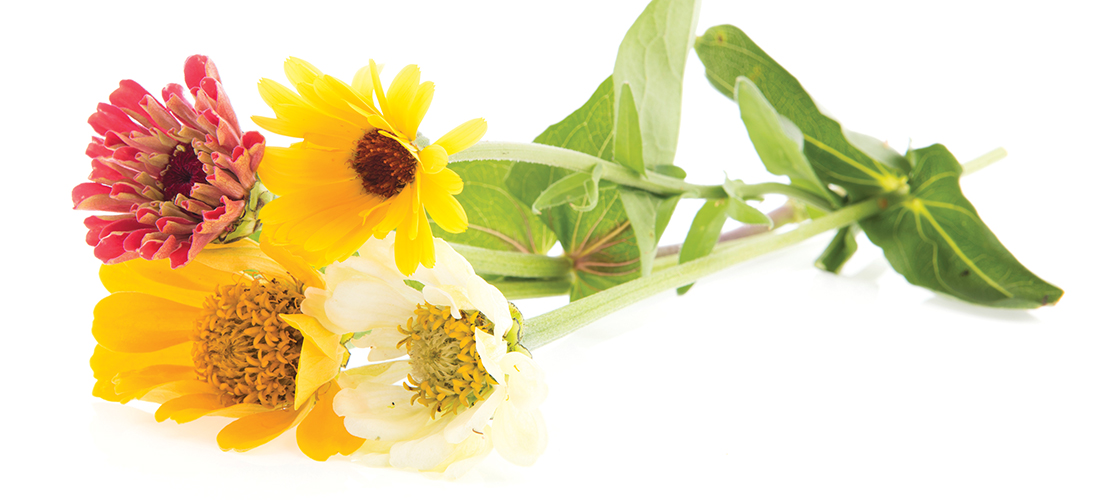
The Cutting Garden
Man does not live by vegetables alone
By Jan Leitschuh
What is a kitchen garden but food for the soul? No need to be a vegetable purist. We can add a few flowers to the mix, rendering the entire process far more soulful.
I’m not talking about interplanting a six-pack of bedding marigolds with your tomato plants for pest control. Although those are nice, the stems of bedding plants are too short for most vases.
No, we are dreaming of armloads of garden blossoms for cutting — a true cottage garden profusion.
With certain sown flowers, you’ll draw essential pollinators to your kitchen garden and the vases in your house will spill over with colorful blooms. Your yard will pop with floral eye candy and, since many thrive with regular cutting, you will have plenty of extra flowers to surprise and cheer up friends.
The quiet joy and pride of place is purely incidental.
It usually starts like this:
One chilled, sodden January, I stop before a local display of seeds and tubers. Instantly, the colorful reds, yellows, purples, pinks and oranges vanquish the gray day. In my mind, it becomes late June, and along with plucking ripe tomatoes, yellow squash and snap beans, I’m also gathering loads of cut flowers to bring into the house and share with friends. Bees buzz. The sky is blue, the morning breezes soft.
More than a few bucks later, I come home with many packets of zinnia, poppy, sweet William and cosmos seed, sacks of candy-colored dahlia, a peony tuber or two and several varieties of caladiums.
Come late February to early March, I’m sowing a few trays of my treasures, to get an early start. The remainder will be sown directly in the garden.
While some gardeners plant bulbs especially for cutting — early daffodils and Dutch irises and gladioli and lilies — why not keep it super simple? Let’s not over-complicate the process. A few packets of seed may be all you need to cultivate joy this summer.
You’ll need some sure-thing Sandhills winners.
The suggestions below can be planted directly into your garden. That couldn’t be easier — scratch out a shallow trench, seed lightly, then rake or cover with a sprinkle of soil and pat down for the critical seed-soil contact. Moisten with a gentle spray so that the tiny seeds aren’t disturbed, and water regularly through germination and early growth. Thin or transplant seedlings to the distances stated on the packet, so they have space to develop.
For diehard gardeners, a few trays seeded indoors in late February or early March can give you a jump on the season. I like to sow a six-pack of each variety, then seal the rest of the seeds in a plastic bag, for later direct sowing. This lengthens my growing season and spreads out the likelihood of good blooms.
Some of my favorites do very well here in the Sandhills, thriving with regular cutting, kicking out more blooms. Here are three can’t-miss flowers:
Glorioso Daisy: Practically foolproof. You may have to order these seeds or obtain from a friend. I haven’t seen them on seed racks yet this year, but they are well worth seeking out, and you can save the seed of your favorite blooms to replant next year.
This is a rugged, deer-resistant type of flower with great good cheer, sure to light up an informal summer bouquet. You may also find the seeds under the botanical name rudbeckia hirta.
These daisy-like, tetraploid cultivars are larger and showier than their wild cousins. As a sturdier, more eye-catching type of black-eyed Susan, rudbeckia hirta has blooms that may be golden yellow with dark chocolate centers, or a rich red-mahogany, or a bicolor golden with a mahogany base to each petal.
Another showy type of rudbeckia hirta is called Irish Eyes. This tall strain produces large, single golden-yellow daisies with a bright green eye and makes an outstanding cut flower.
Glorioso daisies also come in doubles. They will bloom through the fall, when their rich autumnal colors add to the season. Deadheading prolongs the bloom season, but gloriosa daisies will re-seed themselves readily.
Sow seeds directly in the ground sometime in April. Consider a second planting in May for longest bloom season. If you’ve planted too close for the optimum 12-inch spacing, the seedlings do transplant well when young, especially if moved on a cloudy day and watered in well.
Glorioso daisy is fairly drought resistant once established and will produce masses of cheerful blooms.
Zinnias: So easy. Again, as simple as seeds come. And the colors! The flower shapes! Possibly my favorite cut flower of all. There are three types of zinnias, so if cutting is your aim, choose well.
1. Short. Avoid these for a cutting garden. You can find potted zinnias at the garden stores in late spring, but most likely they will be these decorative dwarf types, running under 10 inches or so. You might enjoy these cuties at the front of a flower border, but their stems are too short for good cutting. Some of the common dwarf types are the Thumbelina, Magellan and Dreamland series. They are terrific, long-blooming bedding plants but, again, not very useful for vases and arrangements.
2. Medium. The next type are bushy, landscaping zinnias, up to 20 inches and best for bedding plantings. Look for names like Zahara and Profusion series.
3. Tall. The classic cutting garden zinnia eventually grows skyward, with long, strong stems for vases. You’ll have to start these from seed, most likely, but that is not difficult. Either direct seed into the garden when the soil has warmed — later April or May here — or start some seeds early indoors with plenty of light. By fall, your cutting garden zinnias can be 4-feet tall and will need support. I use a floral net, a kind of open, light string fishnet that steadies growing stems. Your garden center may carry them. You can also corral the patch with some twine and a few stakes.
Choosing your colors, shapes and varieties is the most fun, making for a delightful perusal of the catalogs and seed racks. There are spiky cactus types, full dahlia-looking blooms, newer bicolors, and every pastel shade or bold crayon color except blue. (Yes, even green, pale zinnias called Envy or Queen Lime.) Some of my favorites include the Benary Giants (be sure to order a good strong red, and perhaps an orange), Giant Cactus, California Giants, Uproar Rose, Queen Red Lime, Burpeeana Giants, and the 30-inch Cupcake series. A good strong white bloomer like Polar Bear adds a poignant accent to a colorful arrangement.
Or just buy a packet of mixed colors and be done with it.
Cosmos: You remember the movie The Color Purple, don’t you? Those stunning fields of airy, floral glory were cosmos. Another easy seed to sow directly, cosmos comes in purple, white, pinks, lavender, magentas, gold, orange and even a pale lemon.
Cosmos tolerates heat, drought (once established) and poor soil. Sounds like a Sandhills flower, yes?
Cosmos is a worker. Productive plants will produce masses of delicate, colorful beauty. The sizes range from the 18 to 26-inch dwarf, ruffly Apollo series to taller varieties. The Pop Socks series offers interesting shapes, singles and doubles. Both the Sonata and Sensation series are fairly easy to find and are lovely. The red-and-white striped Velouette is quite striking and can grow 26 to 34 inches. Cups and Saucers, with their fun shapes, can reach to 3 to 4 feet. Bright Lights and Ladybird are the salsa of the cosmos world, spouting hot orange, golden and yellow flowers.
Plants get very bushy. They’d appreciate a little extra room to spread out, so space plants 12 to 18 inches apart. Be sure to stake or corral them early, while they are still young. Cosmos also benefit from a technique called pinching, as this will encourage the already highly productive plants to branch even more vigorously.
There are many other flowers to include in a seeded cutting garden. Coreopsis, sunflowers, bachelor’s button, larkspur and sweet William are just a few that look lovely in vases and can be grown from seed. But you won’t go wrong in the Sandhills with the easy three above.
Don’t forget to water during dry spells, especially when plants are in bloom. Deadhead fading blooms. Carry a clean bucket with a little water out to the garden and cut in the mornings before the sun gets hot. Zinnias, in particular, benefit from a change of water every day or two. They can get a little stinky otherwise.
For an arrangement, use what you’ve already got. Slim stems of flowering trees or shrubs, shiny foliage like photinia, hellebore or camellia for filler, sprigs of purple basil. Perennials such as a sweet-smelling phlox, lilies, a peony, a few strands of ivy, perhaps the odd rose could also creep into the bouquet.
April showers can bring a little soul to your kitchen garden. May the fleurs be with you! PS
Jan Leitschuh is a local gardener, avid eater of fresh produce and co-founder of Sandhills Farm to Table.





